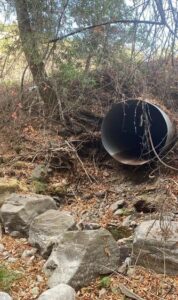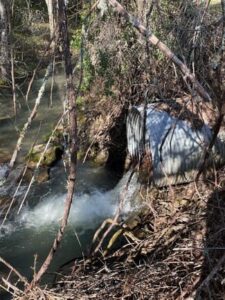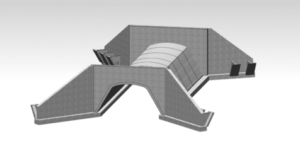 The Napa River and its tributaries support a diverse community of native fishes, including 2 salmonid species: the California Central Coast steelhead trout (Oncorhynchus mykiss), a federally-listed Threatened Species, and Central Valley Fall/Late Fall Run Chinook salmon (Oncorhynchus tshawytscha), a federally-listed Species of Concern under the Endangered Species Act. Steelhead spawning and rearing occurs primarily in the smaller, high-gradient tributary streams (streams with steep slopes and rapid water flows) throughout the watershed, while Chinook spawning and rearing occurs primarily in the mainstem Napa River and low-gradient reaches of some large tributary streams. Both species are anadromous, meaning they need an uninterrupted path from their freshwater spawning and rearing habitat to the ocean, where they spend their adult lives until they return to these streams to spawn, or reproduce.
The Napa River and its tributaries support a diverse community of native fishes, including 2 salmonid species: the California Central Coast steelhead trout (Oncorhynchus mykiss), a federally-listed Threatened Species, and Central Valley Fall/Late Fall Run Chinook salmon (Oncorhynchus tshawytscha), a federally-listed Species of Concern under the Endangered Species Act. Steelhead spawning and rearing occurs primarily in the smaller, high-gradient tributary streams (streams with steep slopes and rapid water flows) throughout the watershed, while Chinook spawning and rearing occurs primarily in the mainstem Napa River and low-gradient reaches of some large tributary streams. Both species are anadromous, meaning they need an uninterrupted path from their freshwater spawning and rearing habitat to the ocean, where they spend their adult lives until they return to these streams to spawn, or reproduce.
Artificial migration barriers constructed during the past century have contributed to population declines of salmonids in the Napa River watershed by limiting access to potential habitat. These barriers range from small temporal barriers, such as road culverts and bridges, that can interrupt fish migration upstream depending on flow conditions, to large-scale permanent barriers, such as dams, which completely cut off access to otherwise suitable habitat.
As part of the County’s continuing efforts to address resource concerns in our watersheds, they have been looking at stream crossings on County maintained roads. County staff have been looking for projects that would prevent large amounts of sediment from being deposited into our creeks, as well as projects that could improve the ability of our native fishes to make it into the farther reaches of their spawning habitat. One of the projects Napa RCD is partnering with the Napa County Department of Public Works and Napa County Flood Control and Water Conservation District on is to replace a culvert that is a fish barrier on Campbell Creek, a tributary to Dry Creek, located in the Napa River Watershed.
In Campbell creek, there is a 6ft diameter culvert which is near the confluence with Campbell Creek and Dry Creek. This culvert was first identified as a fish barrier in July of 1998, during a stream inventory conducted by the California Department of Fish and Wildlife (DFW) and Napa RCD. The culvert was categorized as “red” in the DFW Green-Gray-Red system because it was expected to be a total barrier (impassable to all fish at all flows) due to excessive jump height into the culvert, inadequate jump pool depth, and high downstream water velocities during large storms.

In 2011, as part of a follow-up study to the 1998 stream inventory, Napa RCD assessed the part of Campbell Creek that is above the culvert, to determine the amount and quality of habitat that could be available to steelhead if the stream crossing were improved for fish passage. During this assessment Napa RCD concluded that a natural falls/cascade, located about 0.67 miles upstream of the culvert, was the natural end of high-quality steelhead spawning and rearing habitat. During this assessment Napa RCD observed young-of-year steelhead in this stretch of the creek. It is unknown whether these fish were steelhead or rainbow trout. Given the natural variability in swimming capabilities of individual steelhead, an occasional fish may have been able to pass the culvert under ideal flow conditions.

In 2014 Napa RCD assessed 234 County-maintained stream crossings as part of the County’s TMDL (total maximum daily load) compliance requirement. Based upon cost effectiveness and habit value for steelhead, Napa RCD recommended this same culvert be one of the higher priority sites to be treated. At that time, the County opted to replace another fish barrier, also identified by Napa RCD during this assessment, on Kimball Creek. The culvert on Kimball Creek was in far greater danger of failing due to how degraded the metal pipe had become. Kimball Creek also provides spawning and rearing habitat for both steelhead trout and Chinook salmon.
Public Works is currently working with Stantec Engineering firm to design a bottomless concrete arch culvert to replace the existing culvert. This stream crossing upgrade will increase the flow capacities and allow for better access to upstream habitats for steelhead trout. Public Works and Stantec are currently working on the design of the replacement culvert and working with Army Corps of Engineers, Regional Water Boards, and DFW on CEQA review, permitting, and grant funding opportunities to implement the project. Public Works is planning to have the project implemented by summer of 2024. Because the existing culvert is undersized for peak flows from a 100-yr storm event, upgrading the crossing will also prevent roughly 1,150 cubic yards of sediment from falling into the stream system if the stream crossing were to wash out.

Over the years Napa RCD and other agencies have discovered 79 artificial fish passage barriers in the Napa River watershed. Of those 79, 24 have been removed, 5 are in progress to be removed, and the remaining 50 are being assessed for feasibility and quality of habitat that could be accessible to these salmonids.
